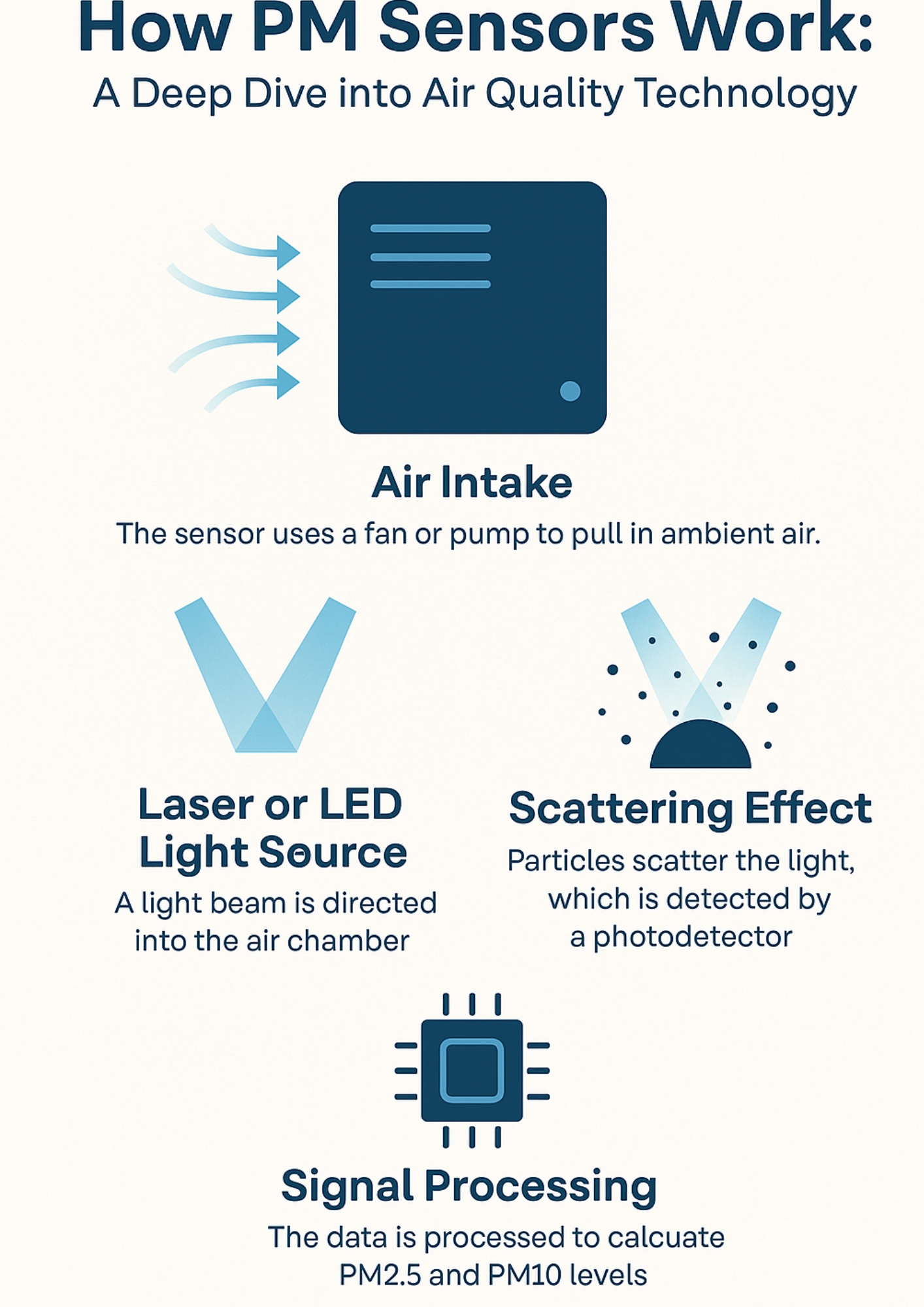

Air pollution has become one of the most serious environmental issues globally. As individuals, industries, and governments search for solutions, Particulate Matter (PM) sensors have become essential tools. But how PM sensors work is still a mystery to many. This blog will explain in simple terms how these devices operate, what makes them accurate, and why they are crucial for maintaining clean air in today’s world.
At https://airatomsmartsolution.com/, we specialize in providing cutting-edge air quality monitoring systems powered by high-precision PM sensors. Understanding how PM sensors work helps you appreciate the technology behind our smart air solutions.

Before exploring how PM sensors work, it’s important to understand what they measure. Particulate Matter refers to tiny solid or liquid particles in the air. These include:
- PM2.5: Particles less than 2.5 micrometers in diameter
- PM10: Particles less than 10 micrometers in diameter
Sources include vehicle emissions, industrial activity, dust, pollen, smoke, and construction debris. These particles can cause serious health issues, especially respiratory and cardiovascular diseases. That’s why it’s crucial to understand how PM sensors work to detect them accurately.

To put it simply, how PM sensors work is based on light-scattering principles. Here’s a step-by-step breakdown:
- Air Intake: The sensor uses a fan or pump to pull in ambient air.
- Laser or LED Light Source: A light beam is directed into the air chamber.
- Scattering Effect: As PM particles pass through the light beam, they scatter light.
- Photodetector: This scattered light is detected and measured by a photodetector.
- Signal Processing: An internal processor interprets the scattering data and calculates the particle concentration.
- Display or Output: The sensor sends real-time PM2.5 and PM10 values to a display or cloud platform.
This process occurs in real time and is extremely efficient. This is the core of how PM sensors work in modern devices.

To better understand how PM sensors work, it’s helpful to look at different sensor types:
1. Optical PM Sensors
These use infrared or laser technology to detect particles. They are the most common and are used in indoor and outdoor air monitors.
2. Gravimetric PM Sensors
These collect particles on filters and weigh them. They are very accurate but not real-time.
3. Beta Attenuation Monitors
These use radioactive beta rays to detect particle density. While precise, they are more suited for industrial use.
At https://airatomsmartsolution.com/, we focus on optical PM sensors because of their balance between cost, speed, and accuracy — a perfect match for today’s real-time monitoring needs.

Knowing how PM sensors work is more than technical curiosity. It allows users to:
- Choose the right product for their needs
- Understand air quality data more accurately
- Maintain and calibrate devices properly
- Trust sensor readings when making health or policy decisions
Whether you’re a homeowner, business, or public official, knowing how PM sensors work ensures smarter choices.

Understanding how PM sensors work also highlights how versatile they are:
- Smart Homes: Detect pollutants from cooking, cleaning products, or smoking
- Schools & Hospitals: Monitor indoor air for vulnerable populations
- Smart Cities: Build air quality networks across urban areas
- Industries: Comply with environmental regulations
At https://airatomsmartsolution.com/, we’ve deployed PM sensor solutions in all of these scenarios to empower cleaner and safer environments.

In modern setups, how PM sensors work is part of a larger system. They often connect to:
- Wi-Fi or GSM modules
- Cloud-based data platforms
- Mobile applications
- AI-based predictive tools
The sensor collects the data, transmits it via IoT channels, and provides insights that can be acted upon immediately. This connected ecosystem greatly enhances how PM sensors work in real-world situations.

One of the biggest concerns with sensors is accuracy. How PM sensors work directly impacts their precision. High-end sensors feature:
- Temperature & humidity compensation
- Auto-calibration features
- Dust and water-resistant designs
We ensure all sensors at https://airatomsmartsolution.com/ go through rigorous testing and quality assurance to guarantee reliability.

Now that you know how PM sensors work, you can see why they are such powerful tools in the fight against air pollution. By using laser technology and smart signal processing, these sensors provide real-time, accurate data that supports healthier lives and smarter environments.
At https://airatomsmartsolution.com/, we’re committed to delivering high-quality PM sensor solutions that are reliable, affordable, and user-friendly. Whether you’re a homeowner, school administrator, industry manager, or government agency, understanding how PM sensors work can help you make the best decisions for your air quality needs.

 Cart is empty
Cart is empty
Leave A Comment